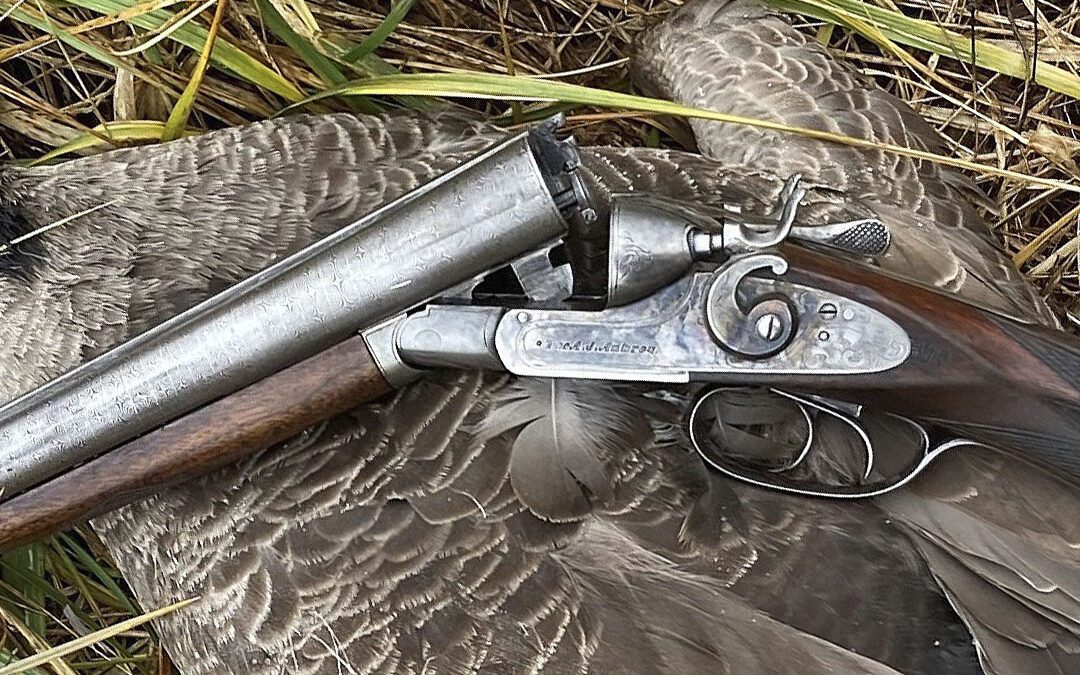With interest in side-by-side shotguns through television programs and vintage shooting, much misinformation exists as to the value of many of these old guns. Most of the finest shotguns in the world are doubles—James Purdey & Sons, Holland & Holland, Westley Richards, etc.—but the simple act of having the barrels laid side by each does not imply or accrue value.
From 1870 through 1930 when the Great Depression struck, thousands of what are best described as trade-name shotguns were made specifically for export to the United States for sale through mail-order houses such as Sears, Roebuck and Montgomery Wards, sporting goods and hardware stores, and gun shops. Many were made in Birmingham, England, but the majority of trade-name shotguns were made in Belgium. On this side of the Atlantic, the Crescent Fire Arms Company, that became Crescent-Warner and ultimately Crescent-Davis, made equally inexpensive doubles with fluid steel barrels that were sold under more than 100 trade names including Knickerbocker, Enders Royal Service, American Gun Co., Keen Cutter, Rocket Special, Vulcan and, the most curious, Rev-O-Noc, which is Conover spelled backward. Charles H. Conover was a vice president of Hibbard, Spencer & Bartlett Hardware in Chicago, which sold Rev-O-Noc guns as its store brand. Once you’ve seen one Crescent, regardless of its trade name, you’ve seen ’em all.
Almost all Belgian-made hardware-store or trade-name shotguns have twist-style barrels and, although inexpensively made, many carry a name implying great value; for example, the Belgian-made W. Richards could easily and usually thought to be a Westley Richards, accruing the value of the bespoke British-made gun. However, Westley Richards always spelled out its name, and its shotguns bear British proof marks, not Belgian; a W. Richards is a $300 wall hanger. Another might be the Parkhurst, close to Parker Brothers, one of the great high-quality American classic doubles; the Parkhurst is a tomato stake. There were a small number of these Belgian-made guns that were a cut above the hardware-store guns. One example is J.P. Clabrough & Bros. that were imported through a San Francisco gun shop. Better finished and of better materials, I have a twist-steel-barreled 10 gauge—bought at a gun show for $300—that Briley Manufacturing converted to a 12 gauge with a set of steel chamber sleeves. The sleeves, combined with the larger bore, bring the pressures of duck loads down to those managed by the twist-steel barrels. Topped with VX steel screw-in choke tubes, it is a fun gun to shoot.
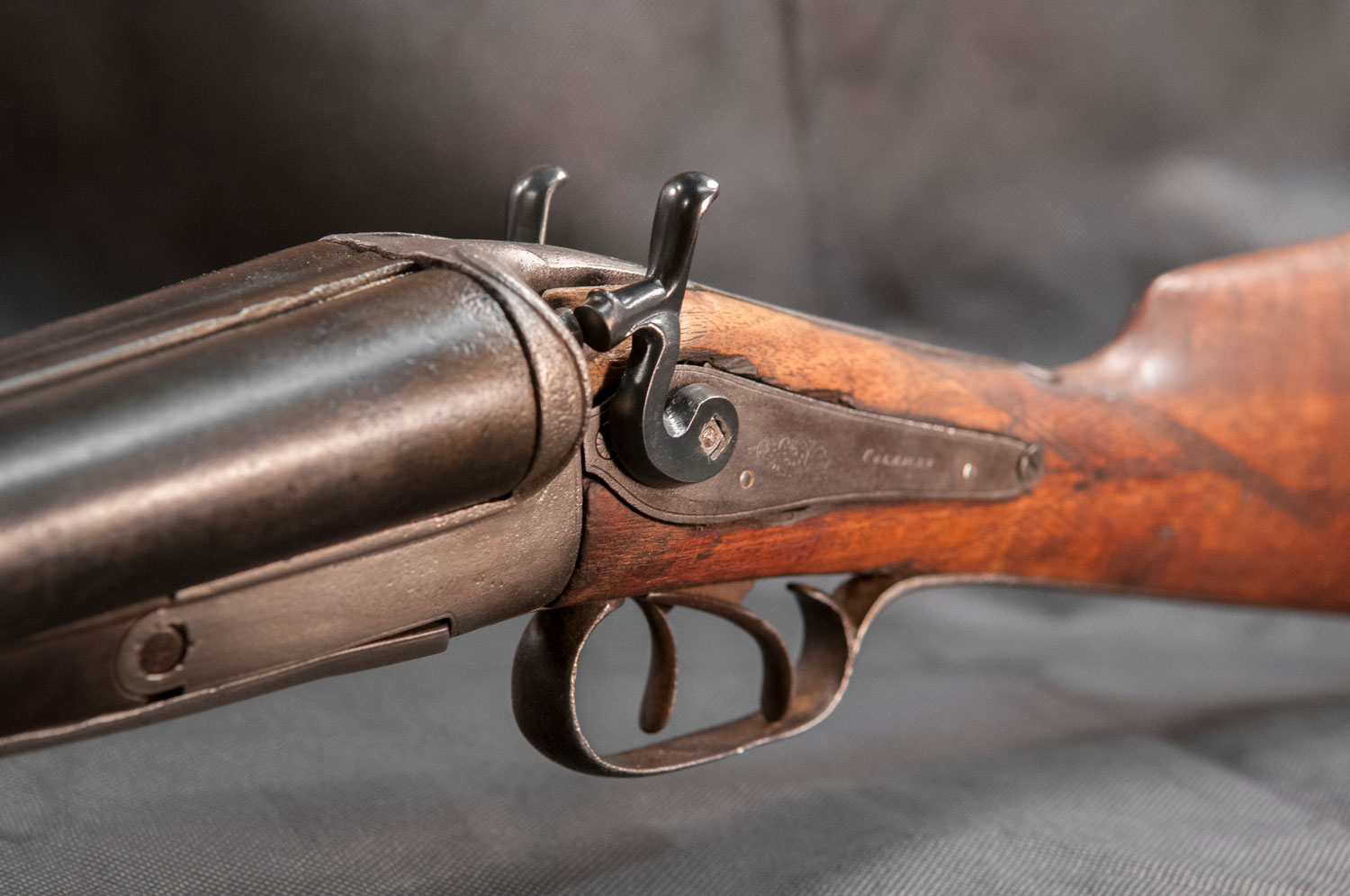
A Coleman 10-gauge restored to wall hanger status.
Many want to learn more about these trade-name shotguns, but other than identifying the parent as a Crescent, Birmingham, England or Belgian, no records exist for these shotguns, regardless of where they were made. Proof marks can identify the country of origin and, within a broad range of years (some country’s proof marks have changed over time), its approximate age, but that’s all.
How many were produced? Pick a number.
Worth? Very little.
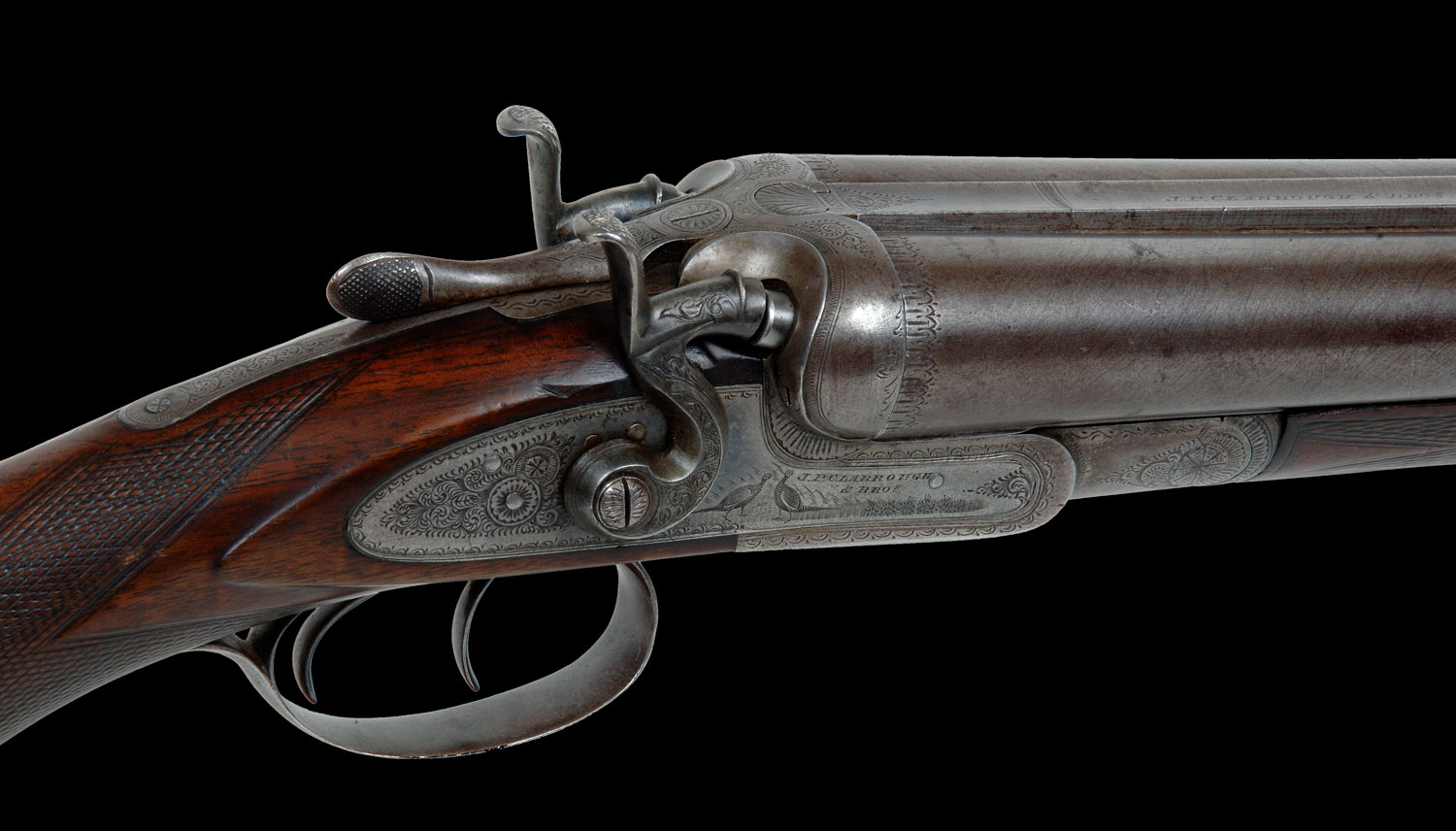
J.P. Clabrough & Bros. hammer double. A mid-range priced Damascus-barreled double when new, it was made shootable with modern ammunition with Briely steel chamber tubes.
On the other hand, high-grade shotguns from England and the U.S. frequently have existing records that identify the year of manufacture—some even the month and day—and in many cases, barrel length, chamber length, grade, stock style, weight, etc. can be traced; for whom the gun was made will sometimes show on company records. Over the decades, many of the once independent British companies have consolidated with others, but it is easy to find who now owns whom, and they have always maintained meticulous records. There is often a nominal charge for a letter relating the information contained in the records, which can be as little as the year of manufacture and for whom it was made, or more elaborate depending on the luck of the draw.
Other European-made shotguns can be more difficult to figure out. Certainly, the Italian makers have ready access to serial numbers, but continental Europe is a different story. Two World Wars ravaged Germany, France and Belgium, which were major gun-making countries. Because many shotguns were the work of independent gunmakers whose shops were obliterated, it makes their potential for identification double difficult. The German Gun Collectors Association is especially helpful in identifying guns of German origin, many of which were brought back as war trophies by returning GIs.
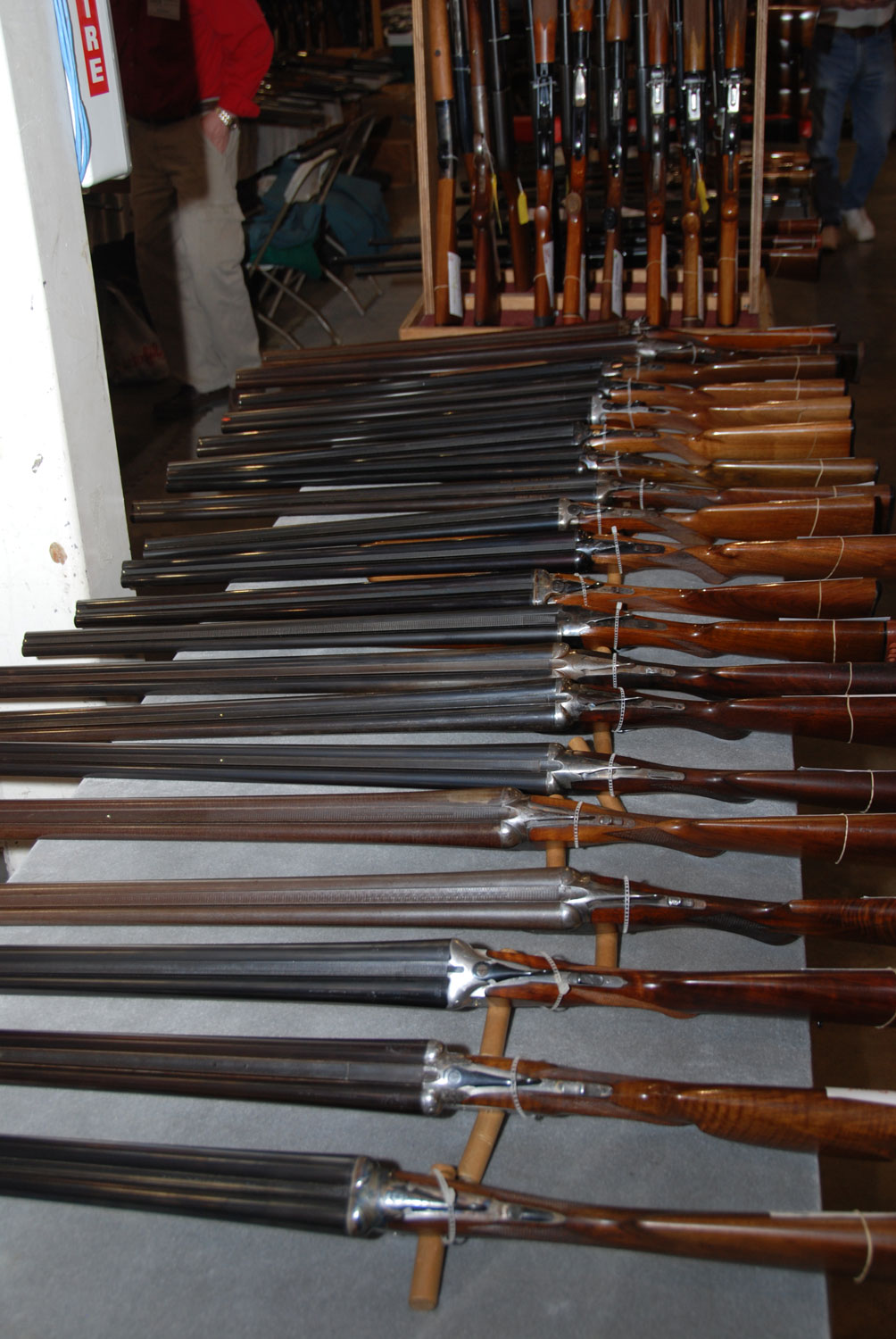
Gun show table full of doubles ranging from great names to wall hangers, and (over) priced as such.
In the United States, most of the records of Parker Brothers, A. H. Fox, L. C. Smith, Lefever, Ithaca and Winchester exist, however, Winchester suffered a serious fire in which some of its records perished. Likewise, the order books of Parker Brothers are incomplete, leaving gaps. The Parker, A. H. Fox and L. C. Smith and Lefever Collectors’ associations have access to the records and, for a modest fee or signing up for a membership, will provide what information they have about a particular shotgun. The Ithaca Gun Company in North Sandusky, Ohio, has serial numbers and dates and is very helpful providing dates of manufacture. There also exists a fairly extensive library of books dedicated to America’s and Britain’s gunmakers and they nearly all include lists of serial numbers. Some may be out of print but can be found online and through sporting-book dealers.
From time to time, I receive letters from individuals wanting information about trade-name guns and frequently seeking repair parts. Parts exist for the Winchester Model 21 and A. H. Fox, because Connecticut Shotgun Manufacturing in New Britain, Connecticut, is currently making those shotguns. The company also offers authentic butt plates, recoil pads and other age-proper accessories for many shotguns. Some Parker and L. C. Smith parts can be found through their collectors’ associations, but parts for most shotguns from this era—1870 to 1930—are usually not available. There is a glimmer of hope as Numrich Gun Parts has a huge catalog of obsolete parts—it even shows parts for Crescent shotguns—but chances are very slim they might actually have what you need.
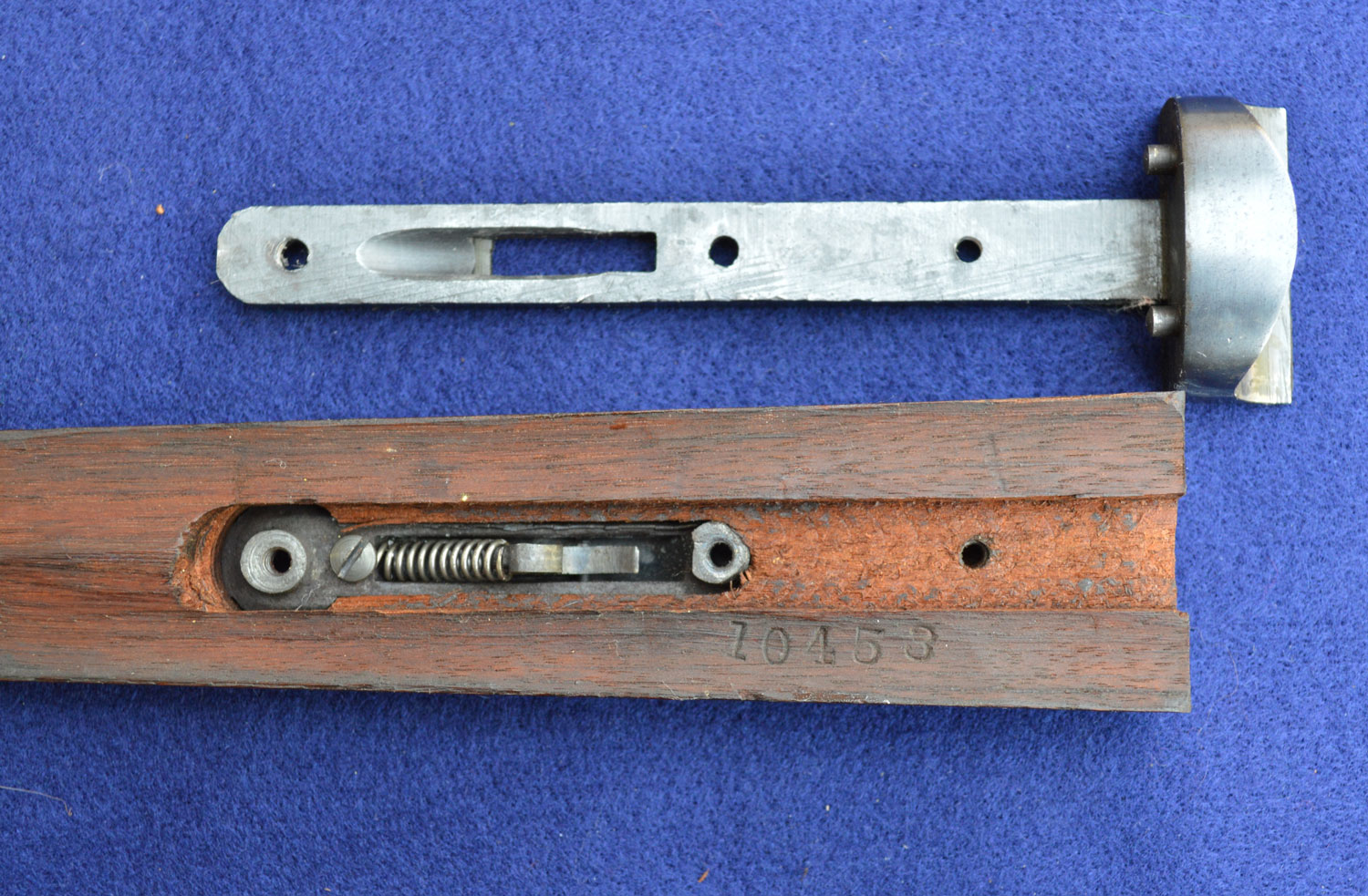
The design of the forend metal and latch limit pathways for oil to enter the wood.
Most frequently asked is where to get a forend that is missing. The problem is not the wood, it’s the iron — the metal that supports the forend and its mechanism that attaches it to the gun. A skilled gunsmith can make a part, but at the current value of trade-name guns, the cost of the part might easily outstrip the value of the gun several times over.

Parkhurst 12-gauge Double Barrel Hammer Shotgun.
Perhaps the oddest letter I received asking for help with a double gun came from a man in Tennessee who had a Holland & Holland Paradox gun and wanted me to suggest a good load for hunting rabbits. Holland & Holland will make you one of these guns for £130,000 plus VAT, so I directed him to its New York gun room where he could sell the gun and buy several rabbit guns with money left over. Intended as a do-all gun for use in Africa, a Paradox gun is a shotgun with the last few inches of the barrels rifled. In use, you can shoot shotshells, but also a solid slug with accuracy because of the rifling. The rifling adds spin to the projectile, but also some spin to the shot cloud that opens the pattern somewhat. In theory you could kill a buffalo with a slug then put spur-winged geese, guineafowl or other birds on the tables for dinner all within a few hours.
Often people want to restore “Uncle Jake’s” double, and in most cases it won’t affect the value. Doug Turnbull, who has been featured on “How It’s Made,” is noted for his excellent restorations of classic firearms. Turnbull has spent hours, days and perhaps years perfecting real bone and charcoal case hardening—not a chemical dip an’ dunk—that matches the hardening on classics such as Fox and Parker. No one, save a blessed few, can go past the door of his case-hardening room. His best advice when dealing with a family heirloom is, “Just clean it up and leave it alone.”
If you plan to shop for a possible shooter at a gun show, it’s probably best to invest in a chamber-length gauge. Winchester normalized its shotgun chambers to 2 3/4 inches in the early 1920s, but many European guns have 2 1/2-inch 12-gauge chambers and 2 9/16-inch 16-gauge chambers.
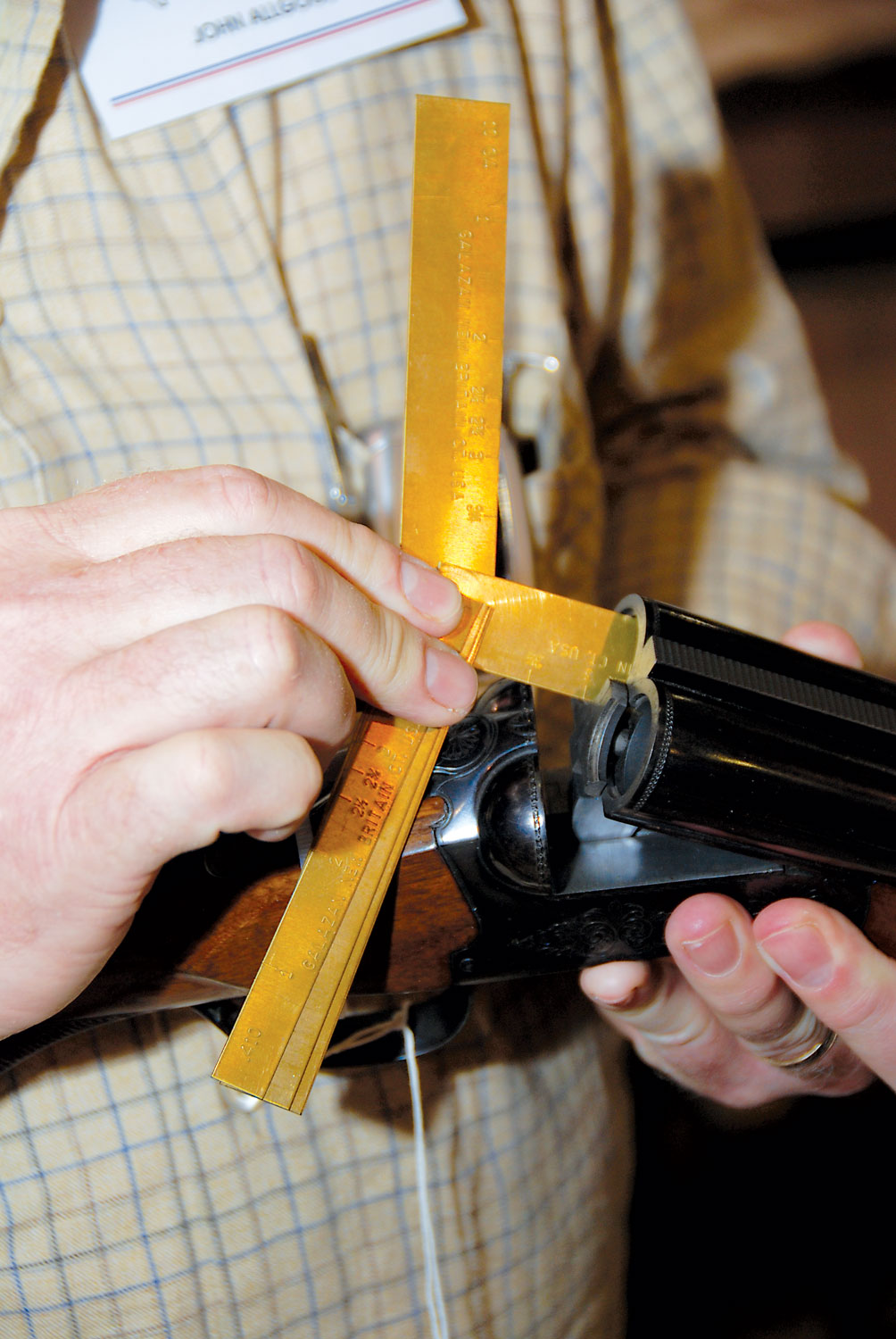
Chamber depth gauge. Handy to have at a gun show to check chamber length.
I was once with a friend who was looking for a good 16, but I cautioned him about two 16s my club friend had at a gun show because both had 2 9/16-inch chambers. (Chambers can be lengthened by a competent gunsmith, but only if there’s sufficient barrel thickness.) When I later apologized to the seller for his not making a sale he asked, “What difference does it make?” So much for that gun-club gun expert. Buyer beware!
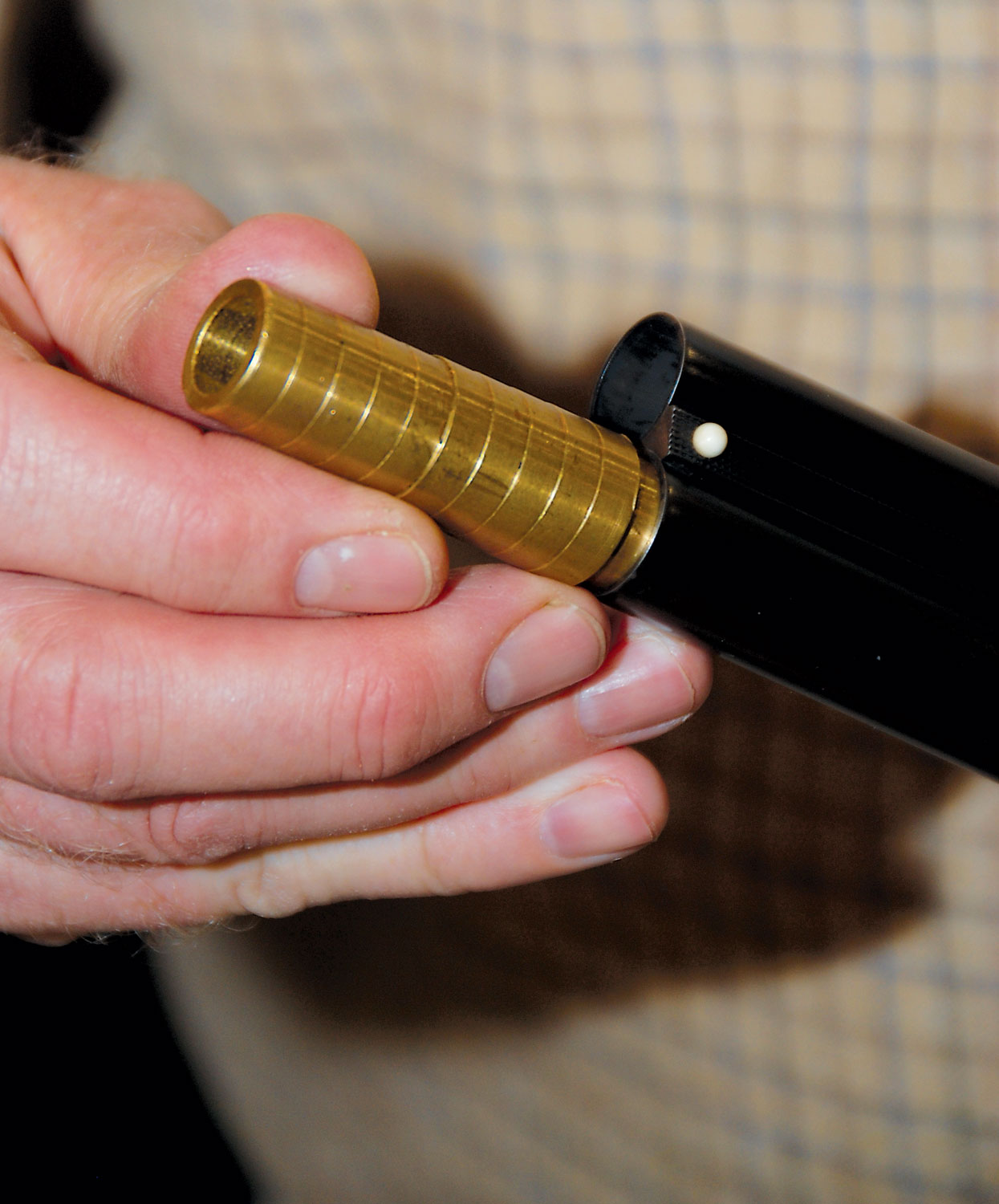
Choke gauge will give an approximation of the amount of choke in a barrel.
There are digital bore gauges, barrel thickness gauges and other tools for checking guns, but the casual buyer does not need them. However, a chamber-length gauge is not a bad idea, and maybe a choke gauge. The problem with choke gauges is that they do not reflect the difference between the gun’s cylinder bore and the choke constriction, however, a plug-style choke gauge will give you an idea of the existing choke. There are many other red-flags such as barrels of a strange length, or those whose separation at the muzzle is wider than normal, as these are warning signs that the barrels have been cut due to damage, other bad occurrence or a nit-wit gunsmith.
One thing to be wary of are twist or “Damascus” barrels. They were considered excellent in the days of blackpowder with its low breech pressure, but then came smokeless powder and many are not capable of handling its higher pressures. Twist barrels are made of alternating strips of steel and iron that are heated, twisted into ribbons then welded into a barrel. The number of alternating strips determined the grade and were reflected in the gun’s price; the more elaborate and hence the greater number of steel and iron strips the higher the price. Some of these many-layered Damascus-style barrels have absolutely astonishing patterns, including faces and other imbedded art. Unfortunately, with corrosive blackpowders and primers the iron strips easily corrode, and the barrels become honeycombed with pockets of rusted metal that can then fail. Some twist barrels were made to appear as steel barrels, and an easy test for them is to put a dab of nitric or muriatic acid on a part of the barrel covered by the forend or elsewhere and, if they are twist, the alternating steel and iron pattern will emerge.
With few exceptions, all trade-name shotguns are wall hangers. None should be fired for any reason. There is a myth that “low-brass” shotshells are somehow safe to shoot in any old clunker. The height of the metal head on a shotshell is absolutely no indicator of the pressure that a particular shell produces and, in some cases, “low-brass” shells generate pressures equal to magnum loads. A Parker, L. C. Smith, Ithaca NID, A. H. Fox or Lefever with steel barrels, and certainly the Winchester 21 are likely safe to use with modern ammunition such as bismuth or Kent’s Tungsten-Matrix where non-lead shot is required and lead in many upland situations.
Don’t forget that a Parker Trojan, Fox Sterlingworth, Lefever Durston Special and L. C. Smith’s Ideal Grade are all basically the same action as their more expensive graded stablemates and are lots of fun if they’re in good condition. Because of their age, however, all should be carefully inspected by a qualified gunsmith familiar with older shotguns before they are fired just to be sure.

